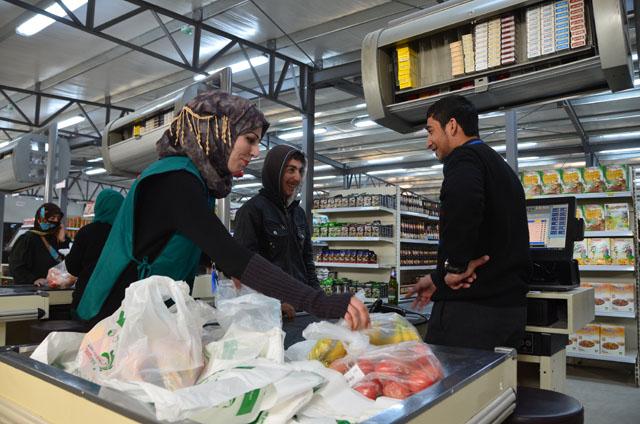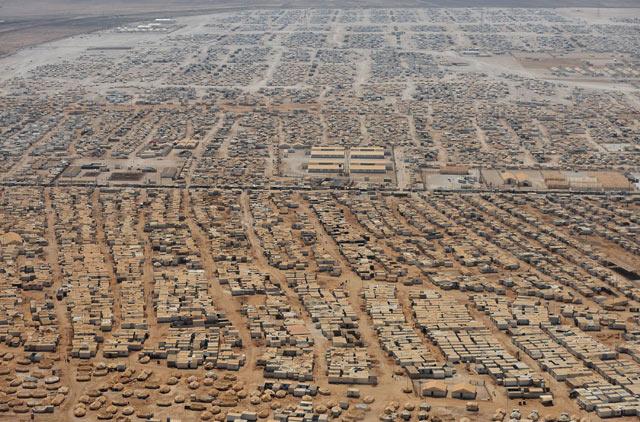You are here
Two hypermarkets offer Zaatari residents variety of foodstuff
By Muath Freij - Feb 06,2014 - Last updated at Feb 06,2014

MAFRAQ — For Um Mohammad, getting food supplies from the scattered vendors at the Zaatari Refugees Camp was a cumbersome daily task.
The mother of nine says prices for the same item could very greatly from one vendor to another, and she could rarely find all the items she wanted.
However, this is no longer the case now that two hypermarkets have opened in the camp.
“Now, I can find whatever I want in one place. Also, prices are the same and I can be assured that no one will take advantage of me,” she told The Jordan Times on Thursday as she picked her favourite food at one of the new supermarkets.
Um Mohammad is one of several Syrian refugees who will be benefiting from these two markets, which were constructed to give refugees a sense of normalcy, said Laure Chadraoui, public information consultant at the UN World Food Programme (WFP).
The WFP, which led the project to establish of the stores, worked with two companies, Safeway and Tazweed, according to Jonathan Campbell, WFP’s emergency coordinator.
“The idea behind it is that people like a lot of diversity. They like fresh food,” he said.
“Traditionally, humanitarian assistance is always... very basic food, so it is better that we do vouchers where people can go to the shops and choose what they want, and cook what they want for their families,” Campbell told The Jordan Times outside the Tazweed Market at Zaatari.
With vouchers, refugees can choose from a diverse list of food, including fresh produce such as meat, chicken, cheese, fresh vegetables and fruit, and eggs, which are not usually included in conventional food rations.
The voucher has a value of JD18 per person per month and is complemented by a monthly ration of rice, lentils, bulgur wheat, date bars, sugar and salt.
If a refugee gets items worth more than JD18, he has to pay the rest, according to one of the cashiers at the market.
Over the next few weeks, the WFP will gradually reduce the rations and increase the value of the voucher until the camp is assisted entirely through food vouchers at a value of JD24 per person per month, according to a statement from the agency.
Campbell noted that refugees who live among host communities in cities, including Amman, Irbid and Zarqa, will also receive the JD24 vouchers.
The WFP injected over $110 million into the Kingdom’s local economy through vouchers, according to the statement.
In September 2013, the WFP started the gradual transition from the distribution of food parcels to food vouchers, allowing camp residents to buy food from 16 designated shops run by local community organisations.
Campbell noted that the new supermarkets are supervised by the Jordan Food and Drug Administration.
“So we have full confidence in the quality of the food, whereas it is not monitored in these [random] shops in the camp and that’s why we do not work with them,” he added.
Ahmad Mohammad, a Syrian refugee from Daraa, said the new markets will ensure that camp residents eat healthy food.
“These random vendors sometimes sell expired items that might harm our health. We are now sure that all the items at these hypermarkets are safe,” he told The Jordan Times as he pushed his shopping cart.
Col. Zaher Abu Shihab, the Zaatari camp director, noted that residents will switch to the new markets.
“Refugees will be reassured that they will get good quality items, while the goods offered by vendors are exposed to the sun and dust,” he noted.
“This will also help organise the situation in the camp because each family will only get what it needs,” he told The Jordan Times.
Chadraoui said 50 per cent of the markets’ employees are from the city of Mafraq, while the other half are camp residents.
“We wanted to give Mafraq residents the chance to work. We also requested that women join the staff,” she said, adding that the two supermarkets were to get their supplies from the local market.
The WFP is currently assisting over half-a-million Syrian refugees in Jordan. It also provides specialised nutrition products to refugees living in northern governorates.
As the world’s largest humanitarian agency fighting hunger worldwide, the WFP reaches, on average, more than 90 million people with food assistance in 80 countries each year.
Related Articles
The United Nations World Food Programme (WFP) has received a fresh contribution of 500,000 euros ($684,000) from the government of France towards its emergency food assistance programmes supporting thousands of Syrian refugees who have fled to Jordan.
A Safeway supermarket was opened early this month in the Zaatari camp for Syrian refugees in northern Jordan, according to UN officials.
The UN World Food Programme (WFP) has launched a nutrition programme for the treatment and prevention of moderately acute malnutrition among Syrian refugee women and children living in camps and communities in Jordan, the WFP said Sunday.



















